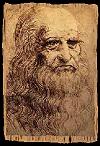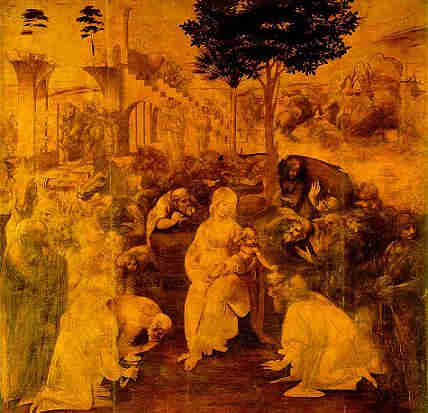|
The Adoration of the Magi measures a sizeable nine feet by eight feet. Leonardo was commissioned in 1480 to paint this work for the main altar of the monastery of San Donato a Scopeto, near Florence. He was to complete it within thirty months, but it remained largely unfinished and was left behind in Florence when Leonardo set out for Milan the next year. The original contract for this painting was particularly complicated with the monks offering Leonardo payment in the form of a third of some land they had received in a bequest. Rules were attached to this in that the property was unable to be sold for the three years following the completion of the painting, except back to the monks and for the price of 300 florins. Along with the land came an outstanding legacy of 150 florins which Leonardo was expected to repay in installments, (this he never did due to lack of money and when the first installment came due he actually requested the monks give him an advance of 28 florins so he could continue work). He was also asked to provide all paints and gold required for the panel though limited help was given in the form of an advance. Lastly, there was a penalty clause by which Leonardo lost everything if he failed to deliver on time. Leonardo was notoriously unreliable at completing commissioned works. He would devote months to the problems of content and composition but quickly tired of the physical act of carrying out the painting itself.
In Adoration of the Magi we have people of all ages surrounding the Virgin and Child, including some on horseback. Leonardo's work was notable for the way he usually attempted to express almost human emotion in his animals. The stairs of a ruined palace can be seen in the background and a procession of people, both mounted and on foot, approaches to join in the worship. Off to the extreme right and isolated from the rest of the painting stands a shepherd lone boy. It is thought this may be the only ever self-portrait of a young Leonardo and be based on a bronze statue in which he posed for his master Verrocchio. At the time it was common for painters to include themselves somewhere in their works. Among the other figures we can see an old man, his face twisted on the brink of death, there's a young man lost in thought, the Kings of the East and St. Joseph. Behind the Pagan ruins can be seen a stretch of countryside and mounted men fighting a vicious beast. Ruins such as those in Adoration of the Magi were a commonly used symbol to show the decay of paganism after the birth of Christ. The palm tree shown directly behind the Virgin and Child is the Tree of Life. Sixty-six human beings and eleven animals have been counted in this painting. A highly ambitious project, Leonardo was just twenty-nine when he worked on it.
There are many sketches and experimental drawings in existence which were done in preparation for this painting, in fact more sketches have been found for this artwork than any other piece by Leonardo. People were drawn in a myriad of poses, horses were sketched and re-sketched. Leonardo held a hope that his prancing horses from the Adoration of the Magi could be successfully cast in bronze. It seems he never did work out an answer to the problem of how to balance the weight of all that bronze on just the hind legs of the rearing animal. The perspective study done for Adoration Of The Magi is much more 'wild' than the final painting and differs in many areas. It shows a tangle of men and animals across the balcony, the arches and stairs in good condition, naked people crawling up them, a man swings an axe as though trying to chop down one of the columns and amidst the mayhem a camel reclines quietly. This is the only time a camel appeared in Leonardo's art and it is unknown where he would have seen such an animal; the best guess was the small zoo then at Florence. In any case this animal and all of the other elements listed above were changed or eliminated once painting commenced. In an even earlier sketch for this painting Leonardo drew the figures of the wise men naked so he could then clothe their forms correctly. Though the Adoration of the Magi never progressed beyond its brown ink and yellow ocher groundwork it is recognised as one of his most important works, done at a time when he was taking the final steps away from the influence of his master, Verrocchio. It shows themes which would later appear in much of Leonardo's work, a certain dreamlike quality with an edge of foreboding. When Leonardo departed for Milan Fillippino Lippi was commissioned to complete an alternative painting; this he finished in 1496. |
|


